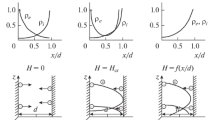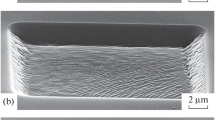Abstract
A first qualitative approach to the importance of the divergence angle and angular distribution of the ions within the broad beam (here called internal beam parameters) on the pattern formation by low-energy ion beam erosion is presented. Si (100) surfaces were irradiated with Kr+, with an ion energy of 2 keV, using a Kaufman type broad beam ion source. It is found that the operating parameters of the broad beam ion source which are responsible for the angular distribution of the ions also affect the pattern formation. Especially, the effect of the acceleration voltage, discharge voltage, grid distance and operation time on the transition from ripple to dot pattern with increasing ion beam incidence angle were analyzed. The results represent additional evidence about the significance of the internal beam parameters and the need of the further investigation of their role on the pattern formation by low-energy erosion.
Similar content being viewed by others
References
G. Carter “The physics and applications of ion beam erosion,” Journal of Physics D: Applied Physics, vol. 34, p. 22, 2001.
W. L. Chan and E. Chason “Making waves: Kinetic processes controlling surface evolution during low energy ion sputtering,” Journal of Applied Physics, vol. 101, p. 46, 2007.
R. Cuerno H. A. Makse S. Tomassone S. T. Harrington and H. E. Stanley “Stochastic Model for Surface Erosion via Ion Sputtering: Dynamical Evolution from Ripple Morphology to Rough Morphology,” Physical Review Letters, vol. 75, p. 4, 1995.
M. A. Makeev R. Cuerno and A.-L. Barabási, “Morphology of ion-sputtered surfaces,” Nuclear Instruments & Methods in Physics Research, section B, vol. 197, p. 43, 2002.
U. Valbusa C. Boragno and F. Buatier de Mongeot, “Nanostructuring surfaces by ion sputtering,” J. Phys.: Condens., Matter vol. 14, p. 22, 2002.
B. Ziberi “Ion Beam Induced Pattern Formation on Si and Ge Surfaces,” in Fakultät für Physik und Geowissenschaften. vol. Doktor Leipzig: Leipzig University, 2006.
B. Ziberi F. Frost H. Neumann and B. Rauschenbach “Ripple rotation, pattern transitions, and long range ordered dots on silicon by ion beam erosion,” Applied Physics Letters, vol. 92, p. 063102, 2008.
B. Ziberi F. Frost M. Tartz H. Neumann and B. Rauschenbach “Importance of ion beam parameters on self-organized pattern formation on semiconductor surfaces by ion beam erosion,” Thin Solid Films, vol. 459, pp. 106–110, 2004.
D. Carbone A. Alija O. Plantevin R. Gago S. Facsko and T. H. Metzger “Early stage of ripple formation on Ge(001) surfaces under near-normal ion beam sputtering,” Nanotechnology, vol. 19, p. 5, 2008.
A. Cuenat and M. J. Aziz “Spontaneous Pattern Formation from Focused and Unfocused Ion Beam Irradiation,” Materials Research Society Symposia Proceedings, vol. 969, p. 6, 2002.
C. Hofer S. Abermann C. Teichert T. Bobek H. Kurz K. Lyutovich and E. Kasper “Ion bombardment induced morphology modifications on self-organized semiconductors surfaces,” Nuclear Instruments & Methods in Physics Research, section b, vol. 216, p. 7, 2004.
F. J. Ludwig C. R. J. Eddy O. Malis and R. L. Headrick “Si(100) surface morphology evolution during normal-incidence sputtering with 100-500 eV Ar+ ions,” Applied Physics Letters, vol. 81, p. 3, 2002.
M. Tartz “Simulation des Ladungstransportes in Breitstrahlionenquellen,” in Fakultät für Physik und Geowissenschaften. vol. Doktor Leipzig: Leipzig University, 2003.
M. Zeuner H. Neumann F. Scholze D. Flamm M. Tartz and F. Bigl “Characterization of a modular broad beam ion source,” Plasma Sources Sci. Technology, vol. 7, pp. 252–267, 1998.
F. Frost B. Ziberi A. Schindler and B. Rauschenbach “Surface engineering with ion beams: from self-organized nanostructures to ultra-smooth surfaces,” Appl. Phys. A, vol. 91, p.9, 2008.
R. Becker and W. B. Herrmannsfeldt “IGUN- A program for the simulation of positive ion extraction including magnetic fields,” Review of Scientific Instruments, vol. 63, p. 3, 1992.
M. Tartz E. Hartmann and H. Neumann “Validated simulation for the ion extraction grid lifetime,” Review of Scientific Instruments, vol. 79, p. 02B905, 2008.
Author information
Authors and Affiliations
Corresponding author
Rights and permissions
About this article
Cite this article
Cornejo, M.I., Ziberi, B., Tartz, M. et al. Importance of Internal Ion Beam Parameters on the Self-organized Pattern Formation with Low-energy Broad Beam Ion Sources. MRS Online Proceedings Library 1181, 140–145 (2009). https://doi.org/10.1557/PROC-1181-DD13-13
Published:
Issue Date:
DOI: https://doi.org/10.1557/PROC-1181-DD13-13




